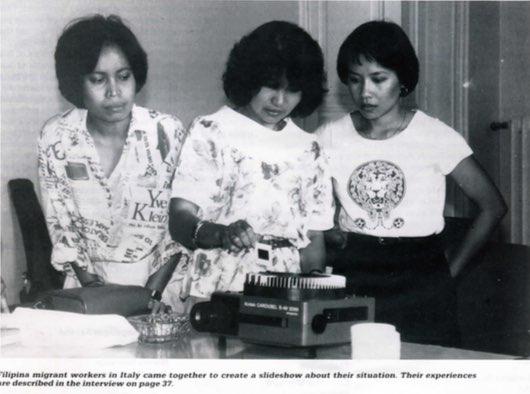Over the past ten years, more and more women have begun to leave our traditional place in front of the camera to stand behind it. From the mountains of Peru to the villages of Bangladesh, women have been using and producing audiovisuals to create new and truer images of ourselves and the world around us. As more and more women master the techniques of film, video and slideshow production, a growing movement is emerging that challenges the dominant images of women presented by the traditional media and the myths they foster. This movement has begun to make women's work and lives visible, showing realities that were never considered "newsworthy" or "glamorous" enough to reach the screen before.
Many of these images may be surprising or disturbing and our reactions help us to see more clearly the distortions imposed on us by the traditional media. For the most part, these media have tended to ignore the difficult conditions faced by an overwhelming majority of women. Today's alternative audiovisuals bring home images of women's double burden as domestic and paid workers, documenting such disparate realities as the harvesting work of poor women plantation workers in Malaysia, the efforts of women in North America to organize against domestic violence, or the oppression and injustice faced by African women living under apartheid.
Unlike most standard commercial audiovisuals, these images are not designed to objectify and exploit women. Nor do they serve to sell us to an uncritical audience. Today's alternative audiovisuals show women who tire and who grow old, but who also rejoice and gather together to organize for a better tomorrow. Frequently they are designed to help us reach the clarity we need to begin taking action, replacing the numbing passivity the traditional media encourage in their audience with a new relationship of empowerment. This relationship involves the producers, the subjects, and the users of media and begins to break down the rigid separation among them.
Such audiovisuals are scattered throughout the world. Many of them have been made by small groups for private or local use, and are rarely, if ever, distributed outside the communities where they were produced. This kind of restricted access severely limits the enormous potential of these resources for helping women around the world to communicate with and learn from each other.
This Audiovisual Resource Guide is the result of Isis International's efforts to bring this great wealth of audiovisuals to light, so that more and more people can have the opportunity to learn about and use these materials. The images described in this book represent a significant part of women's contributions to documenting and creating our own history. At the same time, they provide a valuable guide to understanding the kinds of cultural transformations that many women have been experimenting with in recent years. Finally, these images help to ground contemporary feminism in its sources - the concrete reality of daily life, providing a valuable and visible framework in which to understand today's theoretical debates about gender, sex, race, class and social change.
Like the audiovisuals, this guide is designed as an instrument for reflection and action, aimed at strengthening these new channels of communication.
January 1986
Peggy Antrobus
Barbados
Brigalia Hlophe Bam
South Africa
Kamla Bhasin
India
Elise Boulding
USA
Charlotte Bunch
USA
Miranda Davies
UK
Elisabeth Eie
Norway
Akke van Eyden
Netherlands
Foo Gaik Sim
International Organization of Consumers Unions
Malaysia
Devaki Jain
India
Annette Kaiser
Switzerland
Geertje Lycklama
Netherlands
Mary John Mananzan
Philippines
Giovanna Merola R.
Venezuela
Robin Morgan
USA
Magaly Pineda
CIPAF
Dominican Republic
Ana Maria Portugal
Peru
Rhoda Reddock
Trinidad and Tobago
Luz Helena Sanchez G.
Colombia
Adriana Santa Cruz
Chile
Marie Angelique Savane
Senegal
Norma Swenson
Judy Norsigian
Boston Women's Health Book Collective
USA
Moema Viezzer
Brazil
Maria Villariba
Cherry Padilla
Larainne Sarmiento
Center for Women's Resources
Philippines


